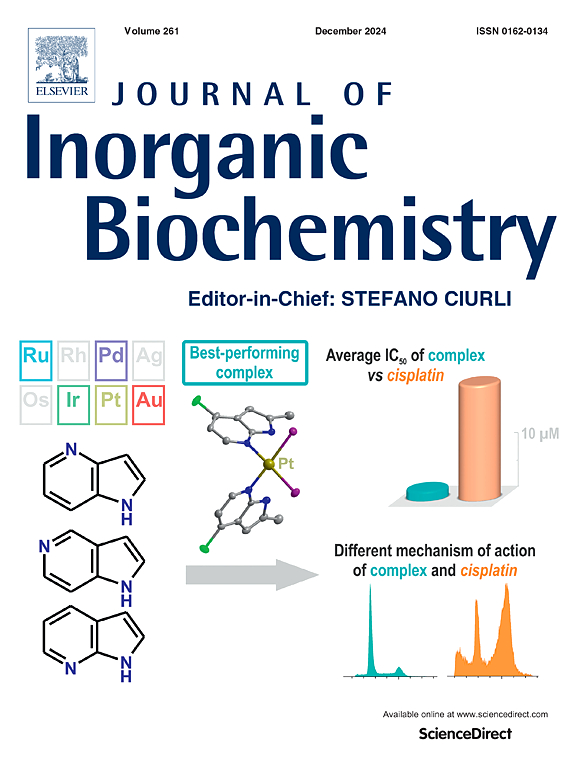血红素和g -四重体DNA之间的相互作用涉及鸟嘌呤的氧
IF 3.8
2区 化学
Q2 BIOCHEMISTRY & MOLECULAR BIOLOGY
引用次数: 0
摘要
鸟嘌呤四聚体是具有转录、翻译调控和端粒保护等多种功能的非规范DNA结构。已知这些结构结合血红素假基,产生血红素结合的g -四联体(血红素- g4),其表现出增强的过氧化物酶活性,并作为有前途的生物催化剂。血红素- g4的结构,特别是DNA支架如何与血红素铁相互作用,是理解这些DNAzymes催化机制的关键。在血红素蛋白中,血红素轴向配体的性质在控制血红素假体的固有反应性方面起着至关重要的作用。关于血红素- g4复合物中血红素轴向配体的几种建议已经提出,包括鸟嘌呤碱基的氮或氧原子或夹在血红素大环和DNA四重体之间的水分子。尽管进行了大量的研究,但尚未提供令人信服的实验证据,以确定关键的近端配体的性质。在这项工作中,我们提出了铁和铁血红素- g4配合物的广泛的电子吸收和共振拉曼光谱研究,包括它们的连接形式。我们的研究通过在铁血红素- g4光谱中563 cm−1处的ν(Fe-OG)拉伸模式的检测,提供了鸟嘌呤碱基的氧原子作为轴向配体的实验证据。这些结果提供了结构数据,可以帮助理解血红素- g4四联体过氧化酶活性增强的机制原理,并有助于设计先进的生物催化剂。本文章由计算机程序翻译,如有差异,请以英文原文为准。

Interactions between heme and G-quadruplex DNA involve the oxygen of guanine
Guanine quadruplexes are non-canonical DNA structures with various functions including transcription and translation regulation and telomere protection. These structures are known to bind the heme prosthetic group, resulting in heme-bound G-quadruplexes (heme-G4) that exhibit enhanced peroxidase activity and act as promising biocatalysts. The structure of the heme-G4, specifically how the DNA scaffold interacts with the heme iron, is key in understanding the catalytic mechanism of these DNAzymes. In heme proteins, the nature of a heme axial ligand plays an essential role in manipulating the inherent reactivity of the heme prosthetic group. Several proposals regarding the heme axial ligand in the heme-G4 complexes have been previously presented, including nitrogen or oxygen atoms of the guanine base or a water molecule sandwiched between the heme macrocycle and the DNA quadruplex. Despite numerous studies, no convincing experimental evidence has yet been provided as to the nature of the key proximal ligand. In this work, we present extensive electronic absorption and resonance Raman spectroscopic studies of ferric and ferrous heme-G4 complexes, including their ligated forms. Our studies provide experimental evidence that the oxygen atom of the guanine base acts as an axial ligand supported by detection of the ν(Fe-OG) stretching mode at 563 cm−1 in the spectra of ferric heme-G4. These results provide structural data that can help understand the mechanistic principles behind the observed enhanced peroxidase activity of heme-G4 quadruplexes and aid in design of advanced biocatalysts.
求助全文
通过发布文献求助,成功后即可免费获取论文全文。
去求助
来源期刊

Journal of Inorganic Biochemistry
生物-生化与分子生物学
CiteScore
7.00
自引率
10.30%
发文量
336
审稿时长
41 days
期刊介绍:
The Journal of Inorganic Biochemistry is an established international forum for research in all aspects of Biological Inorganic Chemistry. Original papers of a high scientific level are published in the form of Articles (full length papers), Short Communications, Focused Reviews and Bioinorganic Methods. Topics include: the chemistry, structure and function of metalloenzymes; the interaction of inorganic ions and molecules with proteins and nucleic acids; the synthesis and properties of coordination complexes of biological interest including both structural and functional model systems; the function of metal- containing systems in the regulation of gene expression; the role of metals in medicine; the application of spectroscopic methods to determine the structure of metallobiomolecules; the preparation and characterization of metal-based biomaterials; and related systems. The emphasis of the Journal is on the structure and mechanism of action of metallobiomolecules.
 求助内容:
求助内容: 应助结果提醒方式:
应助结果提醒方式:


